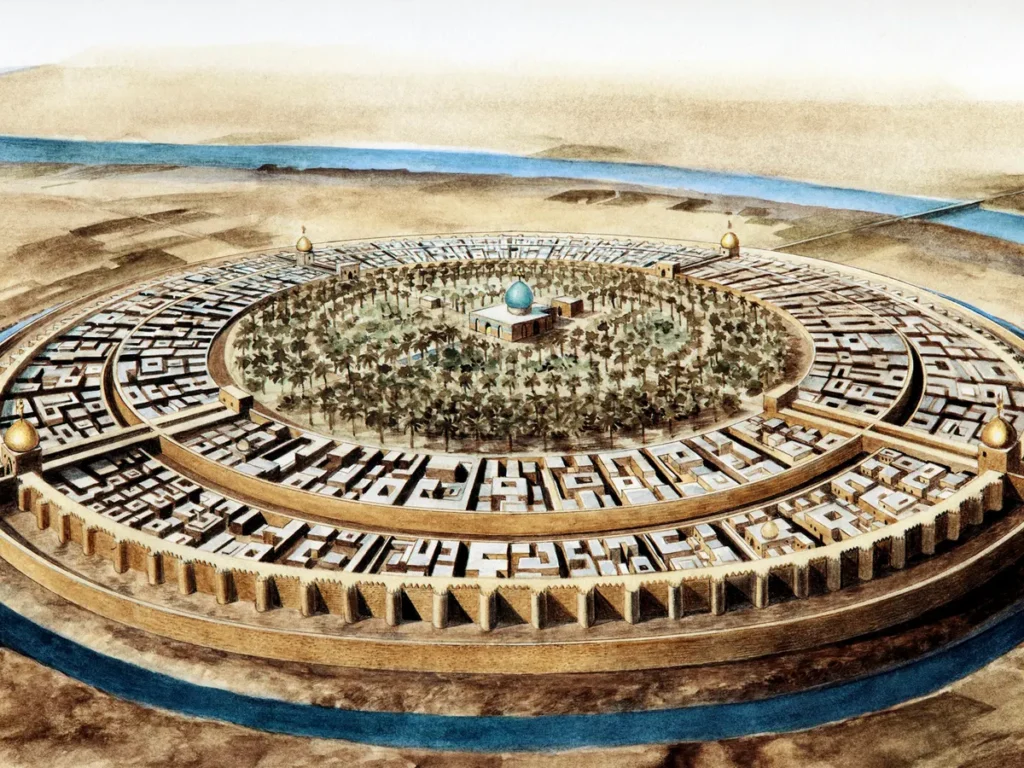Al-Mansur: The Architect of the Abbasid Caliphate

Abu Ja’far Abdullah ibn Muhammad al-Mansur (714–775 CE) was the second caliph of the Abbasid dynasty and one of the most influential rulers in Islamic history. He is best known for consolidating Abbasid power, strengthening the empire’s administration, and founding Baghdad, which later became a center of Islamic civilization. His reign marked the transformation of the Islamic world, shaping the foundations of a golden age of science, culture, and governance.
Foundation of Baghdad
One of Al-Mansur’s greatest legacies was the founding of Baghdad in 762 CE. He envisioned the city as a political, cultural, and economic hub for the Abbasid Caliphate. The city was strategically located near the Tigris River, facilitating trade and military defense.
Baghdad was meticulously designed as a round city, symbolizing unity and power. It became a thriving metropolis, attracting scholars, merchants, and artisans from across the world. Under later rulers, Baghdad evolved into a leading intellectual center during the Islamic Golden Age.
The city was built as a circular walled metropolis, earning the name “Madinat al-Salam” (City of Peace). It had four gates leading to major regions: Khorasan (Persia), Basra, Kufa, and Syria. The Caliphal Palace and Grand Mosque were at the center, symbolizing the centralized power of the Abbasid state.
Baghdad soon became a hub of trade, learning, and governance, setting the stage for its later role as the intellectual center of the Islamic world.

Governance and Administration
Al-Mansur is regarded as one of the most effective administrators in Islamic history. His rule was marked by:
- Centralized Authority: He reduced the influence of Arab tribal elites and incorporated Persian bureaucratic practices, making governance more efficient.
- Economic Reforms: He improved tax collection and fiscal policies, ensuring financial stability for the empire.
- Judicial Reforms: He promoted the development of Islamic law (Sharia) and appointed judges to enforce justice.
- Military Strength: He maintained a strong army, suppressing rebellions and securing Abbasid rule across the vast empire.
Bureaucratic and Economic Reforms
-
Administrative Centralization
- Al-Mansur adopted Persian bureaucratic models, making governance more efficient and merit-based.
- He created Diwans (government departments) to handle finance, military, and justice.
-
Financial Reforms
- The Abbasid economy flourished due to fairer taxation, reducing Umayyad-era favoritism toward Arabs.
- New gold coins (Dinars) and silver coins (Dirhams) stabilized trade.
Challenges and Opposition
Despite his successes, Al-Mansur faced several challenges:
- Shi’a Revolts – Al-Mansur’s rule was constantly threatened by descendants of Ali, especially in Medina and Persia.
- Khazar and Byzantine Raids – Although he prioritized internal stability, border skirmishes with the Byzantines and the Khazar Turks continued.
- Tensions with Persian Elites – While he incorporated Persian culture, some Persian elites resisted Abbasid dominance, longing for their Sassanian heritage.
His ability to crush rebellions while maintaining economic and administrative stability solidified his legacy as a strong ruler.
Patronage of Knowledge and Culture
Al-Mansur was deeply interested in learning and scholarship. He laid the groundwork for the House of Wisdom (Bayt al-Hikma), which later flourished under his successors. He invited scholars from different backgrounds to Baghdad, encouraging the translation of Greek, Persian, and Indian works into Arabic.
He also supported advancements in mathematics, astronomy, medicine, and philosophy, paving the way for the intellectual achievements of the Islamic Golden Age.
Death and Legacy
Al-Mansur died in 775 CE while on a pilgrimage to Mecca. His son, Al-Mahdi, succeeded him as caliph. His legacy endured through the continued expansion and prosperity of the Abbasid Caliphate.
Historians remember him as a ruthless yet visionary ruler, who laid the foundations for one of the greatest empires in Islamic history. His establishment of Baghdad and reforms in governance and administration ensured the Abbasid dynasty’s dominance for centuries.

Conclusion
Al-Mansur’s reign was a turning point in Islamic history. His contributions to state-building, culture, and administration played a crucial role in shaping the Islamic world. By founding Baghdad and fostering intellectual growth, he set the stage for the Abbasid Golden Age, making him one of the most significant figures in Muslim history.


